
Test setup and results …
To measure the volume, one fan was controlled via a controller in the removed state. All measurements in this test were taken using a highly sensitive instrument microphone from a distance of 100 cm. As a comparative value, 10 dB corresponds to a completely quiet room without any special sound insulation. 20dB is audible running noise, 30 dB, on the other hand, is disturbing humming/noise.
| SWAFAN GT14 | SWAFAN GT12 | |||||||
|---|---|---|---|---|---|---|---|---|
| PWM | Speed | Air pressure | Air Flow | Rev Air Flow | Speed | Air Pressure | Air Flow | Rev Air Flow |
| % | rpm | dB | dB | dB | rpm | dB | dB | dB |
| < 30 | 455 | 12,1 | 12,1 | 12,1 | 540 | 12,2 | 12,1 | 12,1 |
| ~ 40 | 745 | 13,2 | 12,8 | 12,8 | 675 | 12,9 | 12,5 | 12,7 |
| ~ 60 | 1200 | 18,1 | 17 | 18,8 | 1150 | 15,4 | 14,7 | 15,2 |
| ~ 80 | 1600 | 24,4 | 22,7 | 23,7 | 1600 | 17,5 | 17,1 | 18,8 |
| 100 | 1920 | 30,7 | 27,1 | 30,8 | 2020 | 21,6 | 21,3 | 22,3 |
The speed of the SWAFAN GT fan is controlled via a PWM signal. This enables very low speeds without having to pay attention to a minimum starting voltage, as the power supply to the motor is always 12V.
The SWAFAN GT fans do not have a 0 rpm mode; they rotate at approx. 500 rpm even with a 0% PWM signal. However, they are completely inaudible. Only from approx. 1200 rpm (60% PWM) do the fans become acoustically noticeable. As expected due to their function, the high-air-pressure fan blades are somewhat louder than the high-air-flow fan blades. But even the reverse airflow fan blades do not manage to remain as quiet as the variant with normal airflow direction.
The 140mm fans are significantly quieter than the smaller GT12 fans, but of course they also move significantly more air and generate a slightly higher static pressure. From approx. 1500 rpm (75% PWM), the 140mm fans are clearly audible even in a closed and insulated housing and at full speed they are almost unpleasantly loud.
The 120mm fan, on the other hand, remains pleasantly quiet up to approx. 1500 rpm and is still pleasantly quiet, albeit audible, even at full speed.
Field test on AIO …
For the first practical test, two SWAFAN GT12s were mounted on the radiator of a Silverstone Vida 240 Slim AiO. The fan blades for high static air pressure were of course used for the fans.
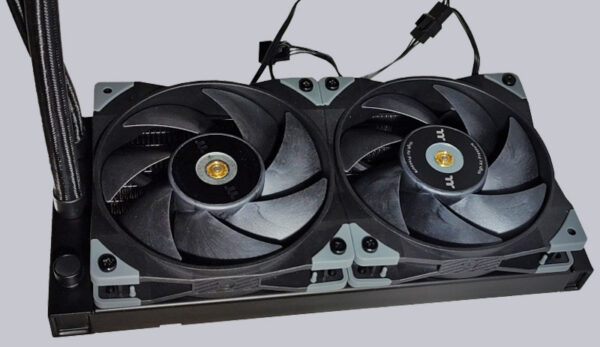
The cooling performance of the AiO was then tested on the benchtable with an MSI MEG X570 ACE and Ryzen 7 5800X.
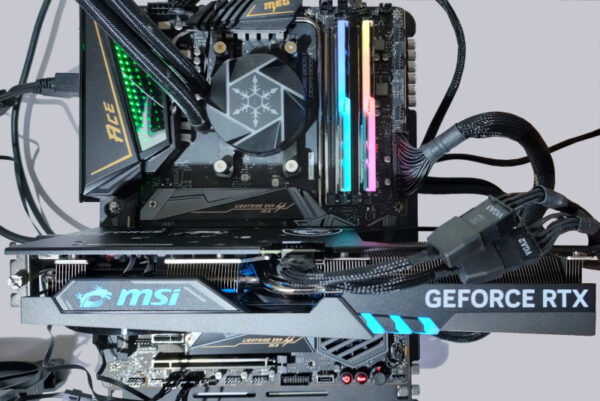
For full processor utilization, the Torture Test of the Prime95 tool was run for 15 minutes and then the temperature was monitored with HWInfo for a further 5 minutes. The water cooling pump and the Thermaltake fan were running at maximum speed.
This procedure ensures that the real cooling capacity of the AiO and, above all, the heat exchange at the radiator is decisive for the CPU temperature and not the heat capacity of the cooling liquid. The cooling capacity at the radiator, in turn, is largely dependent on the volume of air transported and the static pressure provided by the fan – in this case the SWAFAN GT12.
The Ryzen 7 5800X is known as a “hothead”, especially under full load on all cores, the CPU is difficult to keep really cool. Temperatures up to 90°C are still within the thermal range of the CPU and do not lead to thermal throttling.
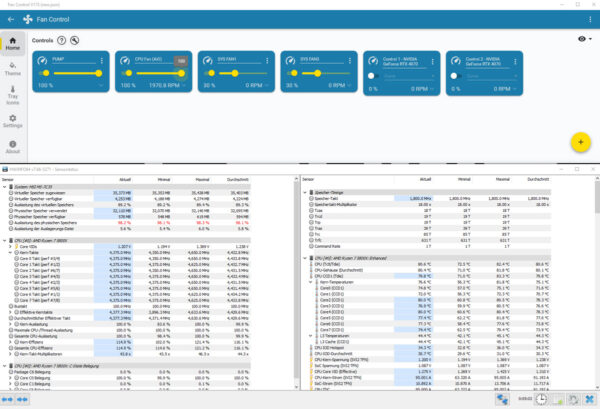
However, as the screenshots show, these temperatures were not even close to being reached. Despite the only 240mm long and 22mm thick radiator, the CPU remained at a stable ~80°C despite full load on all cores. This is an extremely good result for the Thermaltake SWAFAN GT12.
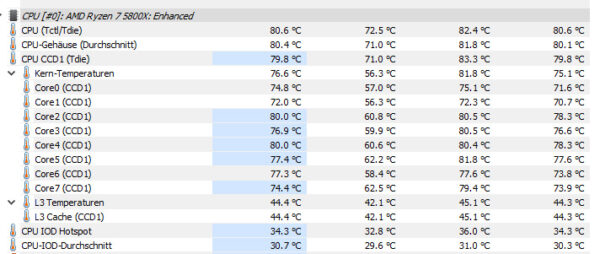
Field test in PC enclosure …
For the second practical test, a complete PC test system was installed in a Fractal Design Pop Air case. The pre-installed 140mm fans in the front were replaced by two Thermaltake SWAFAN GT14, which were equipped with fan blades for High Air Flow.
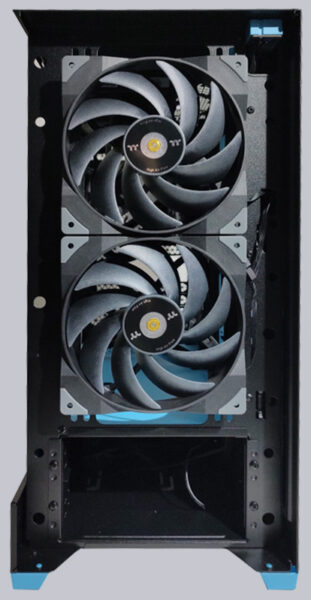
The complete test system:
MSI MEG X570 ACE
Ryzen 7 5800X
G.Skill Trident Z RGB DDR4 32 GB
WD Blue SN570 m.2 NVME SSD 2TB
MSI RTX 4070 Gaming X Trio
be quiet! Straight Power 11 650W
Silverstone Vida 240 Slim with 2x Thermaltake SWAFAN GT12 (High Air Pressure)
Fractal Design Pop Air with 2x Thermaltake SWAFAN GT14 (High Air Flow)
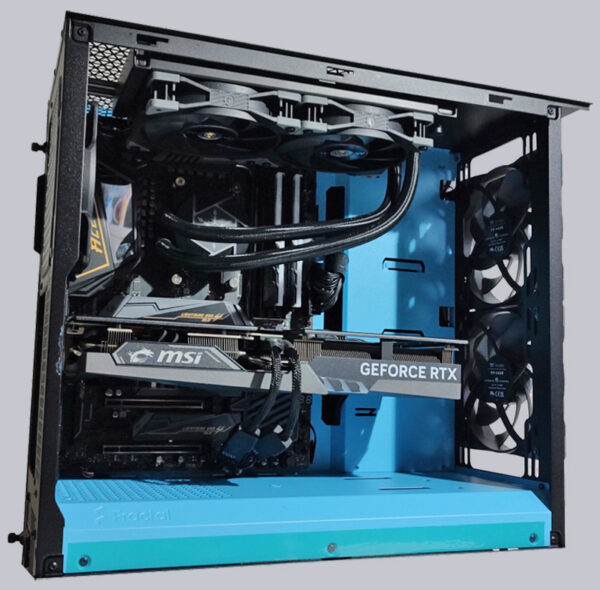
The stress test of the benchtable was repeated in the closed housing. The SWAFAN GT14s supplied the interior of the housing with fresh air at full speed. In a closed system, whether the CPU cooling can develop its full performance depends above all on the sufficient air supply through the case fan and optimum airflow within the case. The measured temperatures give a clear picture. The good values of the benchtable are even slightly undercut, as the case fan can directly supply the AiO with cool air in more than sufficient quantities.
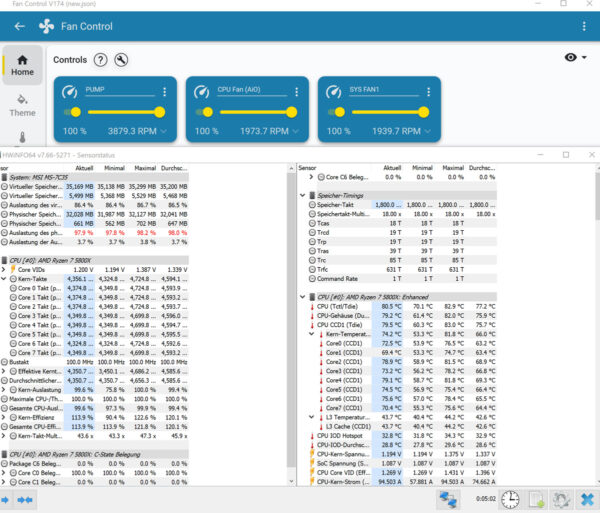
The video with smoke tubes to determine the air flow impressively shows the performance of the Thermaltake GT14 with the High Air Flow fan blades.
Thermaltake SWAFAN GT12 and GT14 Result and general impression …

